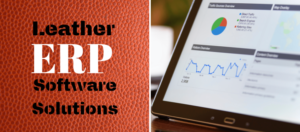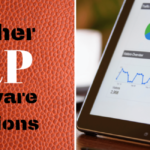Revolutionizing Leather Manufacturing with ERP Software
In the dynamic landscape of manufacturing, efficiency and precision are paramount, and the leather industry is no exception.
As leather manufacturing continues to evolve, the integration of cutting-edge technology becomes essential for staying competitive.
One such technological innovation making waves in the leather manufacturing sector is Enterprise Resource Planning (ERP) software tailored specifically for the industry.
1. The Leather Manufacturing Landscape
Leather manufacturing is a complex process involving multiple stages, from raw material procurement to the final product.
Traditional methods often relied on manual processes and disparate systems, leading to inefficiencies, errors, and delays. In an era where speed and accuracy are key, the industry has embraced ERP software as a game-changer.
2. Streamlining Operations
ERP software in leather manufacturing acts as a central hub, connecting various departments and processes.
From order management and procurement of raw materials to production planning and quality control, every aspect of the manufacturing process is seamlessly integrated.
This not only eliminates the need for redundant data entry but also provides real-time insights into the entire production cycle.
3. Supply Chain Visibility
One of the critical challenges in leather manufacturing is managing the intricate supply chain. ERP software empowers manufacturers with end-to-end visibility, allowing them to monitor raw material inventories, track shipments, and optimize procurement processes.
This level of transparency enables better decision-making, reduces lead times, and minimizes the risk of stockouts or overstock situations.
4. Quality Control and Compliance
Maintaining product quality is paramount in the leather industry. ERP software facilitates rigorous quality control by automating inspection processes and tracking quality metrics throughout production.
Additionally, with ever-increasing regulatory requirements, ERP systems ensure that manufacturers stay compliant with industry standards and regulations, reducing the risk of penalties and reputational damage.
5. Improved Collaboration
Effective communication and collaboration among different departments are crucial for successful manufacturing. ERP software fosters collaboration by providing a centralized platform where teams can share information, coordinate tasks, and respond promptly to changing requirements.
This not only enhances overall efficiency but also promotes a culture of teamwork and innovation.
6. Real-Time Analytics
In the fast-paced leather manufacturing environment, the ability to make informed decisions quickly is a significant competitive advantage.
ERP software leverages real-time analytics to provide actionable insights into production performance, sales trends, and market demand.
Manufacturers can use this data to identify areas for improvement, optimize production schedules, and capitalize on emerging opportunities.
7. Scalability and Flexibility
The leather industry is characterized by fluctuating demand and evolving market trends. ERP software offers scalability and flexibility, allowing manufacturers to adapt to changing business conditions.
Whether scaling up operations to meet increased demand or adjusting production processes in response to market shifts, ERP systems provide the agility needed to thrive in a dynamic industry.
Frequently Asked Questions (FAQs) about Revolutionizing Leather Manufacturing:
What does “Revolutionizing Leather Manufacturing” mean in the context of this article?
Answer: “Revolutionizing Leather Manufacturing” refers to the transformative impact of implementing ERP software in the leather industry, leading to increased efficiency, precision, and competitiveness.
2. How does ERP software contribute to the revolution in leather manufacturing?
Answer: ERP software plays a key role by streamlining operations, providing supply chain visibility, ensuring quality control, fostering collaboration, leveraging real-time analytics, and offering scalability and flexibility to adapt to industry changes.
3. Why is efficiency considered paramount in the leather manufacturing landscape?
Answer: Efficiency is crucial in leather manufacturing to reduce errors, eliminate delays, and enhance overall productivity, which are all addressed by the implementation of ERP software.
4. How does ERP address the challenges faced by traditional methods in leather manufacturing?
Answer: ERP replaces manual processes and disparate systems, reducing inefficiencies, errors, and delays associated with traditional methods, thus addressing challenges and promoting a more streamlined approach.
5. Can ERP software handle the complexity of the leather manufacturing process?
Answer: Yes, ERP software is designed to handle the complexity of the entire leather manufacturing process, from raw material procurement to the final product, by integrating various stages and providing a centralized platform.
6. What role does ERP play in improving collaboration among different departments in leather manufacturing?
Answer: ERP fosters collaboration by offering a centralized platform for effective communication, information sharing, and task coordination among different departments, promoting a culture of teamwork and innovation.
7. How does ERP contribute to better decision-making in the fast-paced leather manufacturing environment?
Answer: ERP leverages real-time analytics to provide actionable insights into production performance, sales trends, and market demand, enabling manufacturers to make informed and timely decisions to stay competitive.
8. Why is supply chain visibility crucial in leather manufacturing, and how does ERP achieve it?
Answer: Supply chain visibility is essential for monitoring raw material inventories, tracking shipments, and optimizing procurement processes. ERP software provides end-to-end visibility, reducing lead times and minimizing stockouts or overstock situations.
9. Can ERP software adapt to the fluctuating demand and evolving market trends in the leather industry?
Answer: Yes, ERP software offers scalability and flexibility, allowing manufacturers to adapt to changing business conditions, whether scaling up operations to meet increased demand or adjusting production processes in response to market shifts.
10. What benefits do manufacturers gain by embracing ERP for revolutionizing leather manufacturing?
Answer: Manufacturers benefit from increased efficiency, better collaboration, improved decision-making through real-time analytics, enhanced quality control, compliance with industry standards, and the agility to thrive in a dynamic and competitive leather industry.
Conclusion: Revolutionizing Leather Manufacturing
As the leather manufacturing landscape continues to evolve, embracing technology is no longer an option but a necessity.
ERP software has emerged as a transformative force, bringing efficiency, visibility, and collaboration to the forefront of leather production.
Manufacturers that harness the power of ERP systems position themselves for success in an increasingly competitive and demanding market.
By streamlining operations, ensuring quality control, and providing real-time insights, ERP software is revolutionizing the way leather is manufactured, setting the stage for a more agile and responsive industry.






